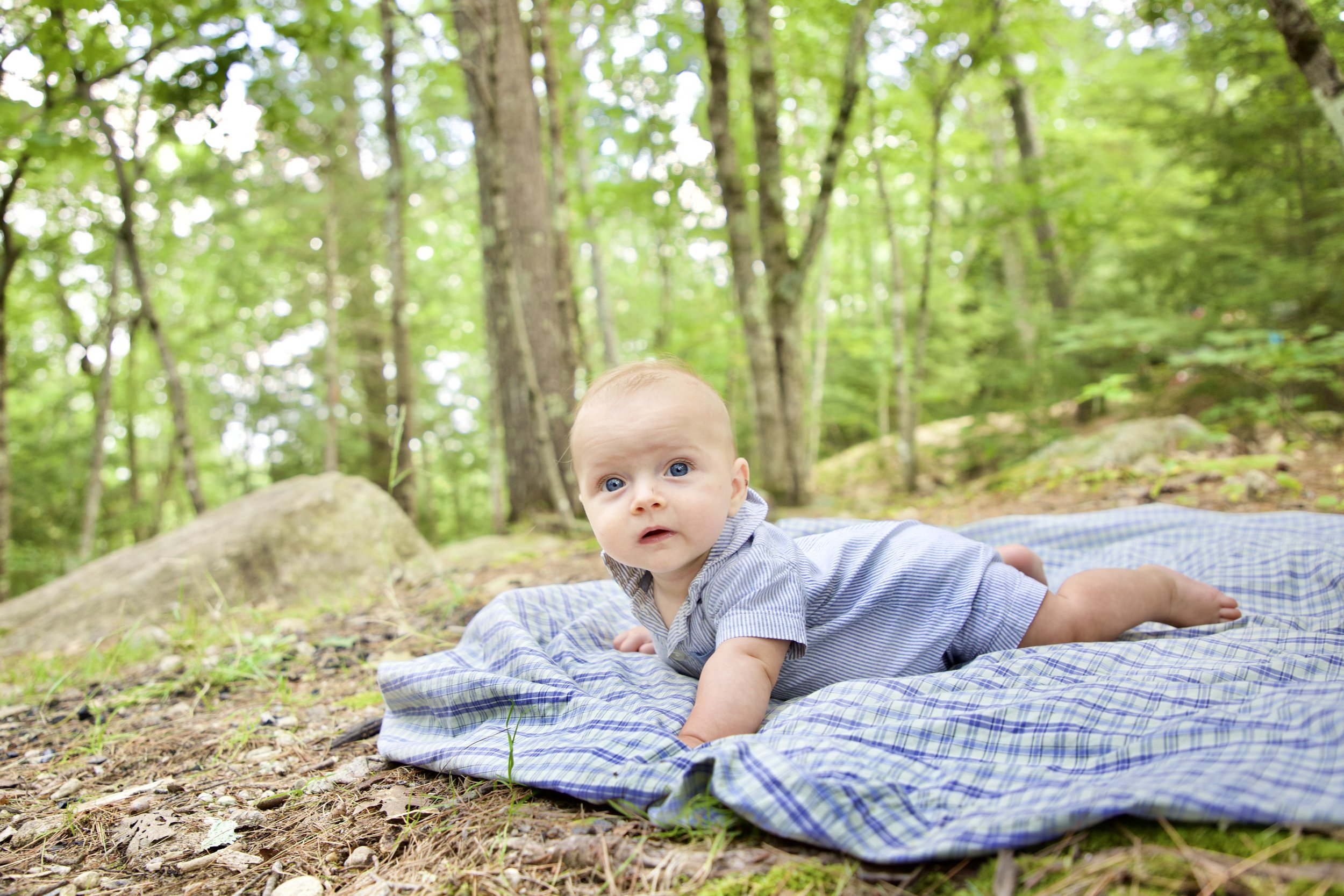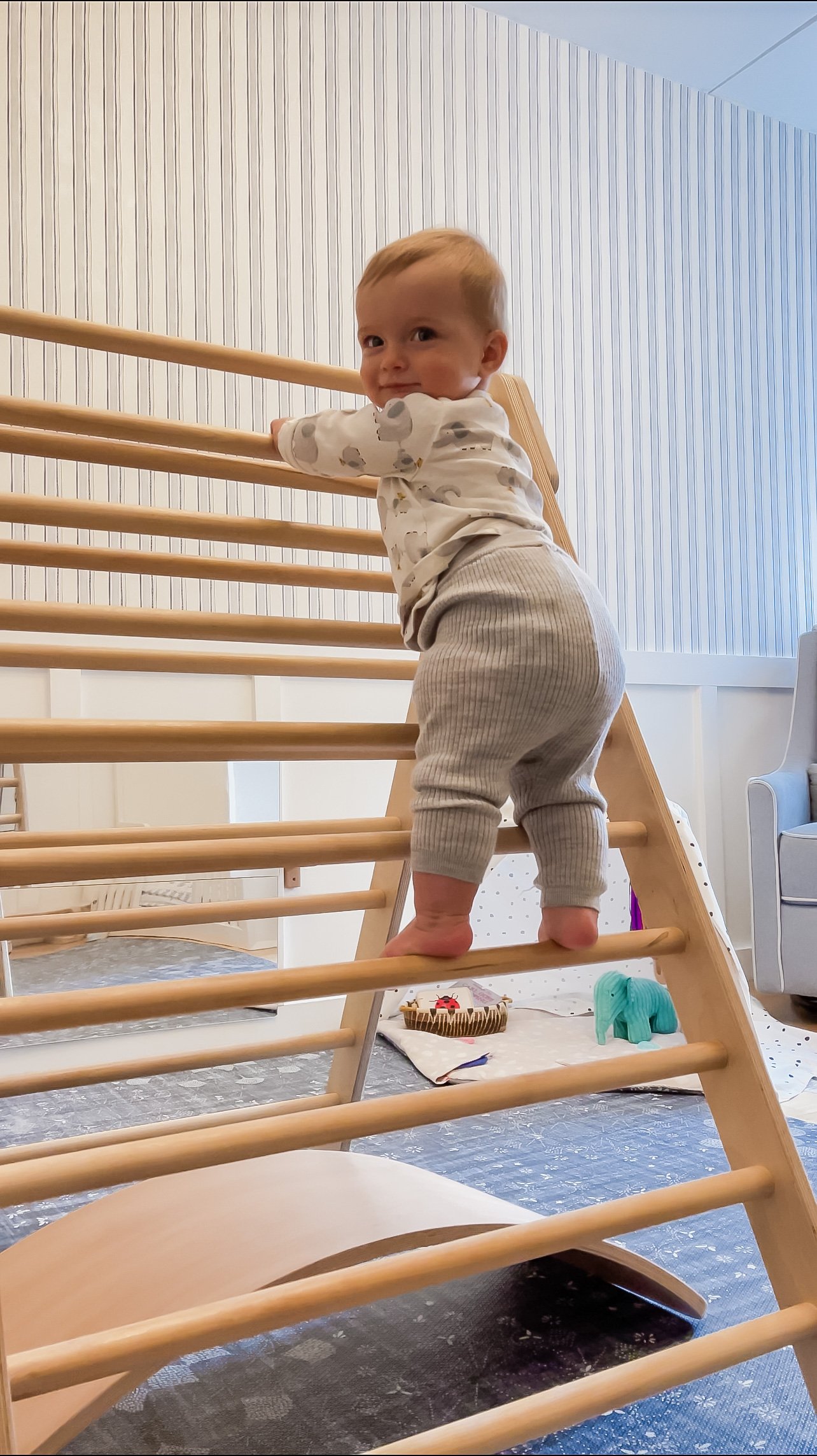Gross Motor Development with Driving Development
This post may contain affiliate links, which means I may earn a small commission if you buy through my link but does not change your price.
What is the number one thing you can do to help your child’s gross motor development? I had a pretty good guess and speaking with Jena, a Pediatric Doctor of Physical Therapy confirmed it.
Of course, every child develops at their own pace and earlier doesn’t mean better. Yitzchak has been advanced on some gross motor milestones and not on others. Both are fine. However, I do credit his early climbing of the Pikler to this.
Can you guess what it is? Yes, freedom of movement aka floor time. We have been doing floor time since day one, for short periods of time in the beginning. As much as possible if he’s not being held we have tried to give Yitzchak time on the floor to explore his surroundings.
Freedom of movement is something talked about a lot in Montessori. Many choose to avoid containers such as bouncers and swings. We used a bouncer for very limited times (he probably spent at most 20 minutes in a bouncer the entirety of infancy). We did have a newborn high chair attachment on our high chair we used so he could join us for meal times. Many also choose to skip the swaddle which I plan to do next time. Much of what many Montessorians do in terms of gross motor development is actually more associated with RIE and Emmi Pikler (who designed the Pikler triangle). Emmi Pikler stressed natural gross motor development and advocated for not placing babies into positions they cannot get into themselves.
Montessori herself also believed strongly in the importance of movement though. She spoke on maximum effort, that a child is pushed to use their maximum abilities in gross motor tasks such as lifting a heavy object. She also stressed how movement was connected to the brain. She saw movement as part of how we learn. Instead of it being separate as “physical education,” Montessori saw movement as part of other subjects like math.
One thing I love about my Ask the Expert series is the ability to speak with an expert on some of these topics that I am so familiar with from a Montessori perspective. This conversation was no different!
For my next installment in my Ask the Expert series I am speaking with Jena of Driving Development. Jena is a Pediatric Doctor of Physical Therapy. She studied Pre-Physical Therapy at Baylor University in Texas on a full academic scholarship. She then attended the University of North Texas Health Science Center where she earned a doctorate in Physical Therapy and graduated top of her class with a 4.0 GPA. After graduating she specialized in pediatrics. She recently took the pediatric certified specialist exam for physical therapy, hoping to become among the top pediatric specialists when the results are released in June. She has two boys, ages 3.5 and 15 months. She provides pediatric physical therapy services in Texas. On Instagram, Pinterest, and TikTok she shares about purposeful play, toy recommendations, and ways to set your baby up for gross motor development success.
What do you primarily do as a pediatric physical therapist?
A primary role as a pediatric physical therapist is education and providing the general public with resources to help their child’s gross motor development–that is what I am aiming to achieve through Driving Development. However, the most rewarding and important job that we have is to provide rehab for children who show a true delay. I work with children of all ages (0-21 years) and all diagnoses including down syndrome, cerebral palsy, muscular dystrophy (to name a few) to help meet their maximal gross motor potential–teaching each child gross motor milestones such as rolling, crawling, walking and higher level gross motor.
What can parents do to support their little one’s motor development in the first year of life? Are there necessary exercises or activities or is an approach of just allowing a lot of floor time sufficient?
The number one thing parents can do to help their littles in the first year of life is LOTS of floor time. Floor time is magic in the pediatric physical therapy world for a few reasons–it provides little ones unrestricted movement to explore their environment and as a result, if there is a true delay that requires intervention it makes those restrictions more apparent and easier to address. The only exercises I encourage parents to actively participate in are floor time and tummy time (from a gross motor perspective). However, I have a lots of ways to provide purposeful play for each child based on their developmental age and if a parent would like advice on how to encourage further milestones, I am happy to do this.
I love that. A term we use in Montessori a lot is freedom of movement!
Can you define “containers”? What are the risks of their use?
It depends on who you ask for a true definition. My professional opinion is: A container is any device that can restrict movement of an infant. Some containers are necessary in certain situations. For instance, a car seat is a necessity for safe transportation, but is still considered a container by this definition. A high chair is also considered a container by this definition. However, I do not want parents to panic over high chair or car seat use–these are necessary and essential items to everyday life and will not cause delay in your child for the short time they are used. The main concern is when containers are used *in excess*. Excessive use is defined as >1 hour a day (not including car seat, high chair or baby wearing time). When used in excess a child does not get the benefits of that unrestricted floor time play that aids and supports their gross motor development.
At what points should parents be concerned about their child’s gross motor development? I know the recent CDC changes led to some confusion for parents.
The new CDC guidelines certainly complicated an already muddy topic! I actually agree with the ages for the milestones changes (although I do think crawling is important and should not be left out). I have always emphasized the importance of *age ranges* for developmental skill acquisition. This means that for rolling, for example, a child can achieve this milestone between 3-7 months old. This aligns pretty evenly with the CDC updated guidelines. However, I have always emphasized that in the last 1-2 months of the age range if your child has not mastered the skill, we need to look more in depth at habits and provide some general education and purposeful play to ensure the baby does not fall behind. The CDC does not recommend this, they only refer once a child has not hit the milestone by the age specified (which aligns more with the end of these age ranges)
How do you define risky play? Why is it important?
The concept of risky play is new to me–but I love it! A child reaches his or her maximal potential by challenging the limits of their abilities–this includes gross motor abilities as well and this can occur through challenging limits of stability (risky walking on a balance beam, risky climbing on a Pikler triangle or jungle gym, etc).
Another term that comes up a lot in Montessori is maximum effort. Can you talk a bit about what that is and why it is important?
This is another concept that is new to me but one I appreciate about Montessori learning structure. From a therapeutic treatment standpoint, once a child gets close to mastering a skill, we offer another way to challenge and build on that development to ensure there is continued progress in therapy. There is a correlation to maximum effort in this therapeutic implementation as in order to continue progress, the child needs to continue meeting maximal effort among their successful trials as well.
Can you tell me a bit about the resources you offer?
Of course! I am a pediatric physical therapist and can provide in-person or virtual treatment for those located in Texas. I have a newborn developmental guide for purchase which emphasizes setting your baby up for gross motor success from the beginning (ages 0-3 months). Hint: it involves lots of floor time! I also provide developmental toy recommendations by age, ability, and interest. In addition, I just started a purposeful play preschool group–This will be a month-by-month theme week guide to purposeful play that emphasizes gross motor, fine motor, cognitive and creative development. I am always sharing information via Instagram, TikTok, and Pinterest.
Thank you for speaking with me Jena! You can follow Jena at @drivingdevelopment across all platforms and read more about the company at www.drivingdevelopment.org



